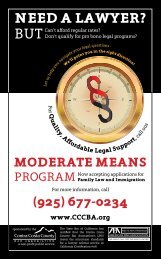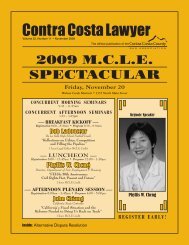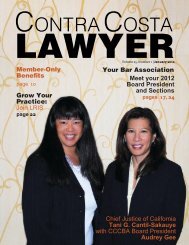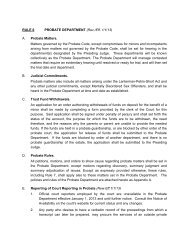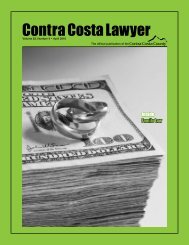download - Contra Costa County Bar Association
download - Contra Costa County Bar Association
download - Contra Costa County Bar Association
Create successful ePaper yourself
Turn your PDF publications into a flip-book with our unique Google optimized e-Paper software.
The Population Cliff<br />
by Perry A. Novak<br />
Demography, the statistical<br />
study of living human<br />
populations, is one<br />
of those detail laden subjects<br />
that just doesn’t lend itself to<br />
much excitement, but demographic<br />
change is about to have a profound<br />
impact on the U.S. economy.<br />
Here Comes the Baby<br />
Boom<br />
Population change normally occurs<br />
at a glacial pace, unless there<br />
is an extreme outside influence.<br />
World War II was just such an influence,<br />
increasing the U.S. birthrate<br />
by more than four million annually<br />
in the years following the war.<br />
From 1946 through 1964 there were<br />
75 million births which gave rise to<br />
the term “baby boom.”<br />
When it comes to us boomers, no<br />
single group has had quite as profound<br />
an impact on the U.S. economy<br />
as we have. Boomers, who now<br />
range in age from 49 to 67, control<br />
over 80 percent of all personal financial<br />
assets, and account for more<br />
than half of all consumer spending.<br />
We are responsible for 80 percent of<br />
leisure travel, 77 percent of prescription<br />
drugs and 61 percent of overthe-counter<br />
drugs.<br />
The rise of the baby boom has<br />
caused tremendous growth in the<br />
U.S. economy, from the housing<br />
boom that started in the 1950s, to<br />
the creation of suburban living that<br />
changed the face of a previously<br />
agrarian nation. Unfortunately, the<br />
rapid retirement of the baby boom<br />
will accelerate some of the country’s<br />
most serious financial problems.<br />
Most of our large-scale consumptive<br />
spending occurs between the<br />
ages of 40 and 55, as we build our<br />
families and acquire the items we<br />
seek to make our lives more comfortable.<br />
After that, and especially<br />
as we approach retirement, our consumptive<br />
spending declines sharply.<br />
Consumer spending accounts for<br />
roughly 71 percent of U.S. gross domestic<br />
product (GDP). That is why<br />
the government usually deals with<br />
economic crises by trying to encourage<br />
consumers to spend. The changing<br />
demographics of the U.S. economy<br />
mean there will be fewer people<br />
in a position to spend us back to a<br />
robust economy.<br />
The second, more dramatic problem,<br />
is really two sides of the same<br />
coin. When we retire, we stop paying<br />
into programs like Social Security<br />
and Medicare and start taking out<br />
benefits. The money starts flowing<br />
the other way, so the costs of these<br />
programs rise dramatically just as<br />
their income is falling off sharply.<br />
More than 10,000 boomers a day<br />
began retiring in 2011 and that<br />
cycle will continue for most of the<br />
next two decades. More than 36<br />
percent claim they have nothing in<br />
retirement savings and 35 percent<br />
of those over age 65 are relying entirely<br />
on Social Security for their retirement<br />
income. An AARP survey<br />
found that 40 percent plan to work<br />
until they die because they did not<br />
plan or save for retirement.<br />
Social Security: Past and<br />
Present<br />
The Social Security program was<br />
created in 1937 and began paying<br />
regular benefits to retirees, age<br />
65 and older, in 1940. At that time,<br />
however, average life expectancy in<br />
the United States was just 58 years.<br />
If someone actually did live to age<br />
65, their remaining life expectancy<br />
was 12.7 years for men and 14.7<br />
years for women.<br />
When the program began, it covered<br />
workers but not spouses or<br />
dependents. It covered roughly 60<br />
percent of the active workforce and<br />
provided a benefit equal to 26 percent<br />
of pre-retirement income. According<br />
to the 1940 census, there<br />
were only nine million Americans<br />
age 65 or older, and only a small<br />
fraction of them received benefits.<br />
The program was originally adopted<br />
to aid retirement only. It did<br />
not include disability payments or<br />
Medicare, both of which were added<br />
much later.<br />
Fast forward to 1990, and the<br />
numbers had changed dramatically.<br />
The number of Americans age<br />
65 and older had climbed from nine<br />
million in 1940 to 34 million, comprising<br />
13 percent of the U.S. population.<br />
Life expectancy had climbed<br />
as well. An expansion of the original<br />
law now covered 96 percent of<br />
the workforce versus the original 60<br />
percent and benefits as a percentage<br />
of pre-retirement wages had<br />
climbed from 26 percent in 1940 to<br />
45 percent in the 1990s.<br />
The increased number of retirees,<br />
living longer and receiving larger<br />
benefits as a percentage of their preretirement<br />
wages, has resulted in<br />
the payroll tax rate being increased<br />
over 500 percent since the program<br />
first began. Fully 80 percent of<br />
American workers pay more in payroll<br />
taxes than they pay in income<br />
taxes. That is why the federal government<br />
temporarily reduced the<br />
employee rate two years ago in an<br />
effort to influence consumer spending<br />
and jump-start the economy.<br />
28<br />
MARCH 2013



